Innovation, Network Capabilities, and Sustainable Development of Regional Economies in China
Abstract
1. Introduction
2. Literature Review
2.1. Regional Innovation Networks and Innovation Development
2.2. Research on the Network Capabilities
2.3. Factors Affecting Regional Innovation
2.4. Research Gaps
3. Research Setting
3.1. Regional Innovation Analysis Framework for the Analysis of Innovation Networks
3.2. Data
3.2.1. Regional Innovation Network Construction
3.2.2. Network Capabilities Data
3.3. Methodology
3.3.1. Spatial Regime Model
3.3.2. Variables
4. Spatial Evolution of Network Capabilities
4.1. Spatial Evolution of Network Capabilities in SKN
4.2. Spatial Evolution of Network Capabilities in TKN
5. Network Capacities and Their Effects on Regional Innovation Development
6. Conclusions and Implications
Author Contributions
Funding
Acknowledgments
Conflicts of Interest
References
- Jensen, M.B.; Johnson, B.; Lorenz, E.; Lundvall, B.Å.; Lundvall, B.A. Forms of knowledge and modes of innovation. In The Learning Economy and the Economics of Hope; Lundvall, B.Å., Ed.; Anthem Press: London, UK, 2016; pp. 155–182. [Google Scholar]
- OECD. OECD Science, Technology and Innovation Outlook 2018: Adapting to Technological and Societal Disruption; OECD Publishing: Paris, France, 2018. [Google Scholar]
- Coe, N.M.; Dicken, P.; Hess, M. Global production networks: Realizing the potential. J. Econ. Geogr. 2008, 8, 271–295. [Google Scholar] [CrossRef]
- Hotz-Hart, B. Innovation networks, regions and globalization. In The Oxford Handbook of Economic Geography; Clark, G.L., Gertler, M.S., Eds.; Oxford University Press: Oxford, UK, 2000; pp. 432–450. [Google Scholar]
- Castells, M.; Cardoso, G. The Network Society: From Knowledge to Policy; Johns Hopkins Center for Transatlantic Relations: Washington, DC, USA, 2005. [Google Scholar]
- Kotabe, M.; Jiang, C.X.; Murray, J.Y. Examining the complementary effect of political networking capability with absorptive capacity on the innovative performance of emerging-market firms. J. Manag. 2017, 43, 1131–1156. [Google Scholar] [CrossRef]
- Simmie, J.; Sennett, J.; Wood, P.; Hart, D. Innovation in Europe: A tale of networks, knowledge and trade in five cities. Reg. Stud. 2002, 36, 47–64. [Google Scholar] [CrossRef]
- Stuck, J.; Broekel, T.; Revilla, D.J. Network structures in regional innovation systems. Eur. Plan. Stud. 2016, 24, 423–442. [Google Scholar] [CrossRef]
- Chen, Z.; Guan, J. The core-peripheral structure of international knowledge flows: Evidence from patent citation data. R D Manag. 2016, 46, 62–79. [Google Scholar] [CrossRef]
- Boschma, R.; Balland, P.A.; Kogler, D. The geography of inter-firm knowledge spillovers in biotech. The Economics of Knowledge. Innov. Syst. Technol. Policy 2016, 6, 147–169. [Google Scholar]
- Vesalainen, J.; Hakala, H. Strategic capability architecture: The role of network capability. Ind. Mark. Manag. 2014, 43, 938–950. [Google Scholar] [CrossRef]
- Parida, V.; Örtqvist, D. Interactive effects of network capability, ICT capability, and financial slack on technology-based small firm innovation performance. J. Small Bus. Manag. 2015, 53, 278–298. [Google Scholar] [CrossRef]
- Parida, V.; Patel, P.C.; Wincent, J.; Kohtamäki, M. Network partner diversity, network capability, and sales growth in small firms. J. Bus. Res. 2016, 69, 2113–2117. [Google Scholar] [CrossRef]
- McGrath, H.; O’Toole, T. Enablers and inhibitors of the development of network capability in entrepreneurial firms: A study of the Irish micro-brewing network. Ind. Mark. Manag. 2013, 42, 1141–1153. [Google Scholar] [CrossRef]
- McGrath, H.; O’Toole, T. A cross-cultural comparison of the network capability development of entrepreneurial firms. Ind. Mark. Manag. 2014, 43, 897–910. [Google Scholar] [CrossRef]
- Yoon, J.; Park, H.W. The unbalanced dynamics in Sino-South Korea scientific and technological collaboration: A triple helix perspective with insights from paper and patent network analysis. Asian J. Technol. Innov. 2017, 25, 184–198. [Google Scholar] [CrossRef]
- Li, D.; Wei, Y.D.; Wang, T. Spatial and temporal evolution of urban innovation network in China. Habitat Int. 2015, 49, 484–496. [Google Scholar] [CrossRef]
- Broekel, T.; Boschma, R.A. Knowledge networks in the Dutch aviation industry: The proximity paradox. J. Econ. Geogr. 2011, 12, 409–433. [Google Scholar] [CrossRef]
- Asheim, B.T.; Grillitsch, M.; Trippl, M. Regional innovation systems: Past–present–future. In Handbook on the Geographies of Innovation; Shearmur, R., Carrincazeaux, C., Doloreux, D., Eds.; Edward Elgar Publishing: Northampton, MA, USA, 2016; pp. 45–62. [Google Scholar]
- Maninggar, N.; Hudalah, D.; Sutriadi, R.; Firman, T. Low-tech industry, regional innovation system and inter-actor collaboration in Indonesia: The case of the Pekalongan batik industry. Asia Pac. Viewp. 2018, 59, 249–264. [Google Scholar] [CrossRef]
- de Vasconcelos, L.A.; Facin, A.L.F.; Salerno, M.S.; Ikenami, R.K. Unpacking the innovation ecosystem construct: Evolution, gaps and trends. Technol. Forecast. Soc. Chang. 2018, 136, 30–48. [Google Scholar]
- Boschma, R. Towards an evolutionary perspective on regional resilience. Reg. Stud. 2015, 49, 733–751. [Google Scholar] [CrossRef]
- Crespo, J.; Boschma, R.; Balland, P.A. Resilience, networks and competitiveness: A conceptual framework. In Handbook of Regions and Competitiveness; Huggins, R., Thompson, P., Eds.; Edward Elgar Publishing: Northampton, MA, USA, 2017; pp. 271–286. [Google Scholar]
- Cairncross, F. The death of distance: A survey of telecommunications. Economist 1995, 336, 5–28. [Google Scholar]
- Martin, R.; Sunley, P. Towards a developmental turn in evolutionary economic geography? Reg. Stud. 2015, 49, 712–732. [Google Scholar] [CrossRef]
- Pike, A.; MacKinnon, D.; Cumbers, A.; Dawley, S.; McMaster, R. Doing evolution in economic geography. Econ. Geogr. 2016, 92, 123–144. [Google Scholar] [CrossRef]
- Scott, A.J. A perspective of economic geography. In Economy; Martin, R., Ed.; Routledge: London, UK, 2017; pp. 3–23. [Google Scholar]
- Angelini, P.P. The role of proximity in inter-organizational network evolution: An application of actor-oriented modeling for longitudinal network analysis. In Relational Methodologies and Epistemology in Economics and Management Sciences; Biggiero, L., Angelini, P.P., Basevi, M., Carbonara, N., Mastrogiorgio, A., Pessa, E., Sevi, E., Valente, M., Eds.; IGI Global: Hershey, PA, USA, 2016; pp. 232–256. [Google Scholar]
- Balland, P.A.; Boschma, R.; Frenken, K. Proximity and innovation: From statics to dynamics. Reg. Stud. 2015, 49, 907–920. [Google Scholar] [CrossRef]
- Friedman, T.L. The World Is Flat: The Globalized World in the Twenty-First Century; Penguin: London, UK, 2006. [Google Scholar]
- Archibugi, D.; Filippetti, A. Knowledge as global public good. In Handbook of Global Science, Technology and Innovation; Archibugi, D., Filippetti, A., Eds.; John Wiley & Sons, Ltd.: New Jersey, NJ, USA, 2015; pp. 479–504. [Google Scholar]
- Lee, N.; Rodríguez-Pose, A. Innovation and spatial inequality in Europe and USA. J. Econ. Geogr. 2013, 13, 1–22. [Google Scholar] [CrossRef]
- Lorenzoni, G.; Lipparini, A. The leveraging of interfirm relationships as a distinctive organizational capability: A longitudinal study. Strat. Manag. J. 1999, 20, 317–338. [Google Scholar] [CrossRef]
- Kale, P.; Dyer, J.H.; Singh, H. Alliance capability, stock market response, and long-term alliance success: The role of the alliance function. Strat. Manag. J. 2002, 23, 747–767. [Google Scholar] [CrossRef]
- Zacca, R.; Dayan, M.; Ahrens, T. Impact of network capability on small business performance. Manag. Dec. 2015, 53, 2–23. [Google Scholar] [CrossRef]
- Mahmood, I.P.; Zhu, H.; Zajac, E.J. Where can capabilities come from? Network ties and capability acquisition in business groups. Strat. Manag. J. 2011, 32, 820–848. [Google Scholar] [CrossRef]
- Walter, A.; Auer, M.; Ritter, T. The impact of network capabilities and entrepreneurial orientation on university spin-off performance. J. Bus. Ventur. 2006, 21, 541–567. [Google Scholar] [CrossRef]
- Ritter, T.; Gemünden, H.G. Network competence: Its impact on innovation success and its antecedents. J. Bus. Res. 2003, 56, 745–755. [Google Scholar] [CrossRef]
- Tyler, B.B. The complementarity of cooperative and technological competencies: A resource-based perspective. J. Eng. Technol. Manag. 2001, 18, 1–27. [Google Scholar] [CrossRef]
- Blomqvist, K.; Levy, J. Collaboration capability—A focal concept in knowledge creation and collaborative innovation in networks. Intern. J. Manag. Concepts Phil. 2006, 2, 31–48. [Google Scholar] [CrossRef]
- Human, G.; Naudé, P. Exploring the relationship between network competence, network capability and firm performance: A resource-based perspective in an emerging economy. J. S. Afr. Inst. Manag. Sci. 2009, 18, 2–14. [Google Scholar]
- Parida, V. Achieving Competitiveness through Externally Oriented Capabilities: An Empirical Study of Technology-based Small Firms; Luleå University of Technology: Luleå, Swedish, 2010. [Google Scholar]
- Ziggers, G.W.; Henseler, J. Inter-firm network capability: How it affects buyer-supplier performance. Br. Food J. 2009, 111, 794–810. [Google Scholar] [CrossRef]
- Teixeira, A.A.; Queirós, A.S. Economic growth, human capital and structural change: A dynamic panel data analysis. Res. Policy 2016, 45, 1636–1648. [Google Scholar] [CrossRef]
- Keklik, M. Schumpeter, Innovation and Growth: Long-Cycle Dynamics in the Post-WWII American Manufacturing Industries; Routledge: London, UK, 2018. [Google Scholar]
- Haans, R.F.; Pieters, C.; He, Z.L. Thinking about U: Theorizing and testing U-and inverted U-shaped relationships in strategy research. Strat. Manag. J. 2016, 37, 1177–1195. [Google Scholar] [CrossRef]
- Etzkowitz, H.; Zhou, C. The Triple Helix: University–Industry–Government Innovation and Entrepreneurship; Routledge: London, UK, 2017. [Google Scholar]
- Crescenzi, R.; Gagliardi, L.; Iammarino, S. Foreign multinationals and domestic innovation: Intra-industry effects and firm heterogeneity. Res. Policy 2015, 44, 596–609. [Google Scholar] [CrossRef]
- Rantala, T.; Ukko, J. Performance measurement in university–industry innovation networks: Implementation practices and challenges of industrial organizations. J. Edu. Work 2018, 31, 247–261. [Google Scholar] [CrossRef]
- Wonglimpiyarat, J. The innovation incubator, university business incubator and technology transfer strategy: The case of Thailand. Technol. Soc. 2016, 46, 18–27. [Google Scholar] [CrossRef]
- Cozzens, S.E. Innovation and inequality. In The Co-evolution of Innovation Policy: Innovation Policy Dynamics, Systems, and Governance; Kuhlmann, S., Shapira, P., Smits, R., Eds.; Edward Elgar: Cheltenham, UK, 2008; pp. 363–385. [Google Scholar]
- Wallace, D. Environmental Policy and Industrial Innovation: Strategies in Europe, the USA and Japan; Routledge: London, UK, 2017. [Google Scholar]
- Bathelt, H.; Malmberg, A.; Maskell, P. Clusters and knowledge: Local buzz, global pipelines and the process of knowledge creation. Prog. Hum. Geogr. 2004, 28, 31–56. [Google Scholar] [CrossRef]
- Un, C.A.; Rodríguez, A. Local and global knowledge complementarity: R&D collaborations and innovation of foreign and domestic firms. J. Intern. Manag. 2018, 24, 137–152. [Google Scholar]
- Hu, G. China’s cost of investment and construction of investment Environment. In The Cost of Development in China; Hu, G., Ed.; Springer: Singapore, 2017; pp. 365–377. [Google Scholar]
- Wei, Y.D.; Liao, H.F. The embeddedness of transnational corporations in Chinese cities: Strategic coupling in global production networks? Habitat Int. 2013, 40, 82–90. [Google Scholar] [CrossRef]
- Wei, Y.D. Network linkages and local embeddedness of foreign ventures in China: The case of Suzhou municipality. Reg. Stud. 2015, 49, 287–299. [Google Scholar] [CrossRef]
- Wei, Y.D.; Zhou, Y.; Sun, Y.; Lin, C.G. Production and R&D networks of foreign ventures in China: Implications for technological dynamism and regional development. Appl. Geogr. 2012, 32, 106–118. [Google Scholar]
- Taylor, P.J.; Derudder, B. World City Network: A Global Urban Analysis; Routledge: London, UK, 2015. [Google Scholar]
- McAdam, M.; McAdam, R.; Dunn, A.; McCall, C. Regional horizontal networks within the SME agri-food sector: An innovation and social network perspective. Reg. Stud. 2016, 50, 1316–1329. [Google Scholar] [CrossRef]
- Jiang, S.; Shi, A.; Peng, Z.; Li, X. Major factors affecting cross-city R&D collaborations in China: Evidence from cross-sectional co-patent data between 224 cities. Scientometrics 2017, 111, 1251–1266. [Google Scholar]
- Wong, P.K.; Singh, A. Do co-publications with industry lead to higher levels of university technology commercialization activity? Scientometrics 2013, 97, 245–265. [Google Scholar] [CrossRef]
- Hennemann, S.; Wang, T.; Liefner, I. Measuring regional science networks in China: A comparison of international and domestic bibliographic data sources. Scientometrics 2011, 88, 535–554. [Google Scholar] [CrossRef]
- Van Beuzekom, B.; Arundel, A. OECD Biotechnolgy Statistics-2006; OECD Publishing: Paris, France, 2006. [Google Scholar]
- Hoekman, J.; Frenken, K.; Van Oort, F. The geography of collaborative knowledge production in Europe. Ann. Reg. Sci. 2009, 43, 721–738. [Google Scholar] [CrossRef]
- Denicolai, S.; Ramirez, M.; Tidd, J. Overcoming the false dichotomy between internal R&D and external knowledge acquisition: Absorptive capacity dynamics over time. Technol. Forecast. Soc. Chang. 2016, 104, 57–65. [Google Scholar]
- Lichtenthaler, U. Determinants of absorptive capacity: The value of technology and market orientation for external knowledge acquisition. J. Bus. Ind. Mark. 2016, 31, 600–610. [Google Scholar] [CrossRef]
- Opsahl, T.; Agneessens, F.; Skvoretz, J. Node centrality in weighted networks: Generalizing degree and shortest paths. Soc. Netw. 2010, 32, 245–251. [Google Scholar] [CrossRef]
- Li, H.; Wei, Y.D.; Liao, H.F.; Huang, Z. Administrative hierarchy and urban land expansion in transitional China. Appl. Geogr. 2015, 56, 177–186. [Google Scholar] [CrossRef]
- Wei, Y.D. Spatiality of regional inequality. Appl. Geogr. 2015, 61, 1–10. [Google Scholar] [CrossRef]
- Huang, H.; Wei, Y.D. Spatial inequality of foreign direct investment in China: Institutional change, agglomeration economies, and market access. Appl. Geogr. 2016, 69, 99–111. [Google Scholar] [CrossRef]
- Anselin, L. The future of spatial analysis in the social sciences. Geogr. Inf. Sci. 1999, 5, 67–76. [Google Scholar] [CrossRef]
- Ertur, C.; Gallo, J.L.; Baumont, C. The European regional convergence process, 1980–1995: Do spatial regimes and spatial dependence matter? Int. Reg. Sci. Rev. 2006, 29, 3–34. [Google Scholar] [CrossRef]
- Cravo, T.A.; Resende, G.M. Economic growth in Brazil: A spatial filtering approach. Ann. Reg. Sci. 2013, 50, 555–575. [Google Scholar] [CrossRef]
- Flores, M.; Rodriguez, O.E. Spillover effects of homicides across Mexican municipalities: A spatial regime model approach. Rev. Reg. Stud. 2014, 44, 241–262. [Google Scholar]
- Dang, J.; Motohashi, K. Patent statistics: A good indicator for innovation in China? Patent subsidy program impacts on patent quality. China Econ. Rev. 2015, 35, 137–155. [Google Scholar] [CrossRef]
- Janger, J.; Schubert, T.; Andries, P.; Rammer, C.; Hoskens, M. The EU 2020 innovation indicator: A step forward in measuring innovation outputs and outcomes? Res. Policy 2017, 46, 30–42. [Google Scholar] [CrossRef]
- Burger, M.J.; Meijers, E.J.; Hoogerbrugge, M.M.; Tresserra, J.M. Borrowed size, agglomeration shadows and cultural amenities in North-West Europe. Eur. Plan. Stud. 2015, 23, 1090–1109. [Google Scholar] [CrossRef]
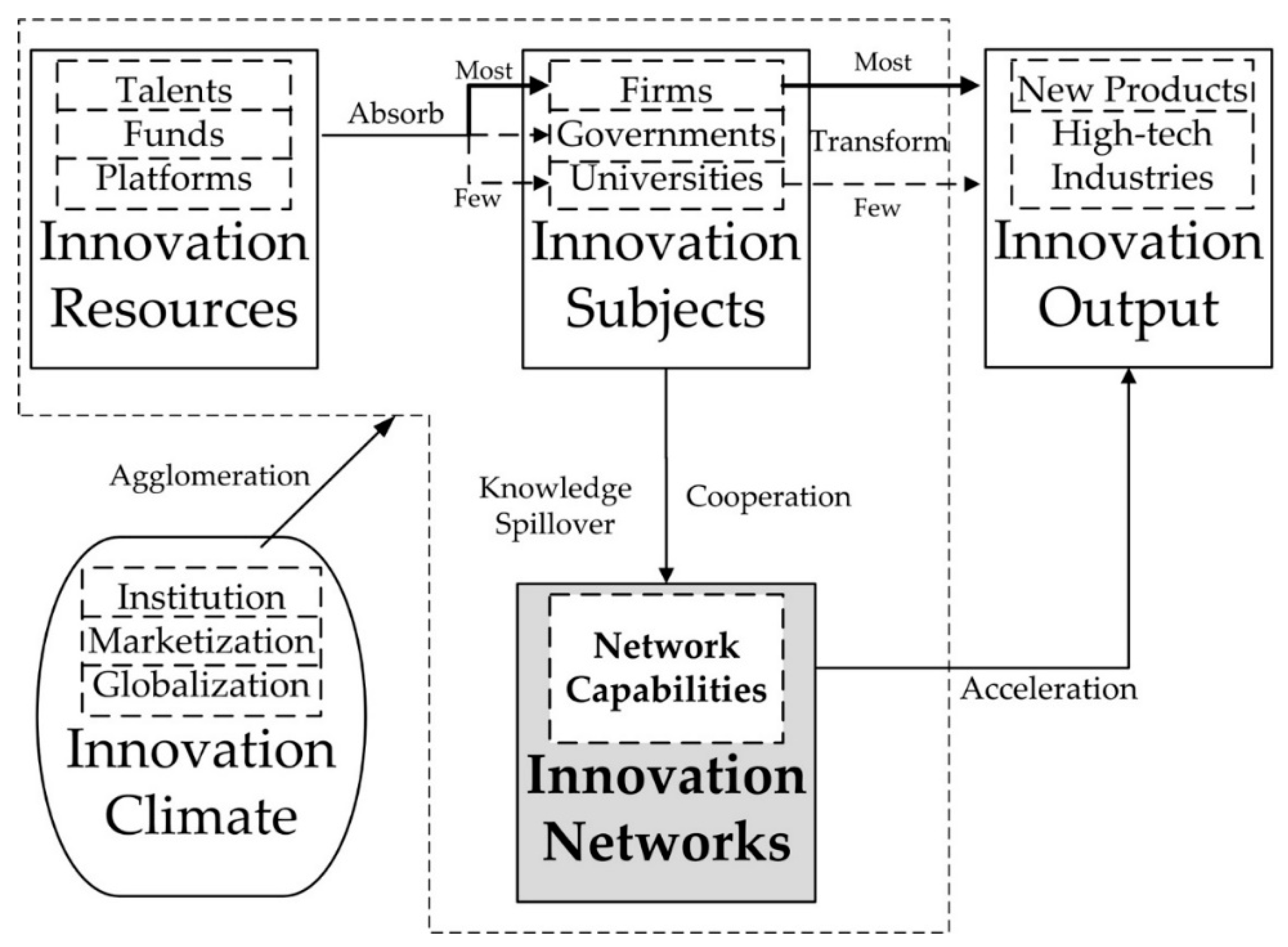

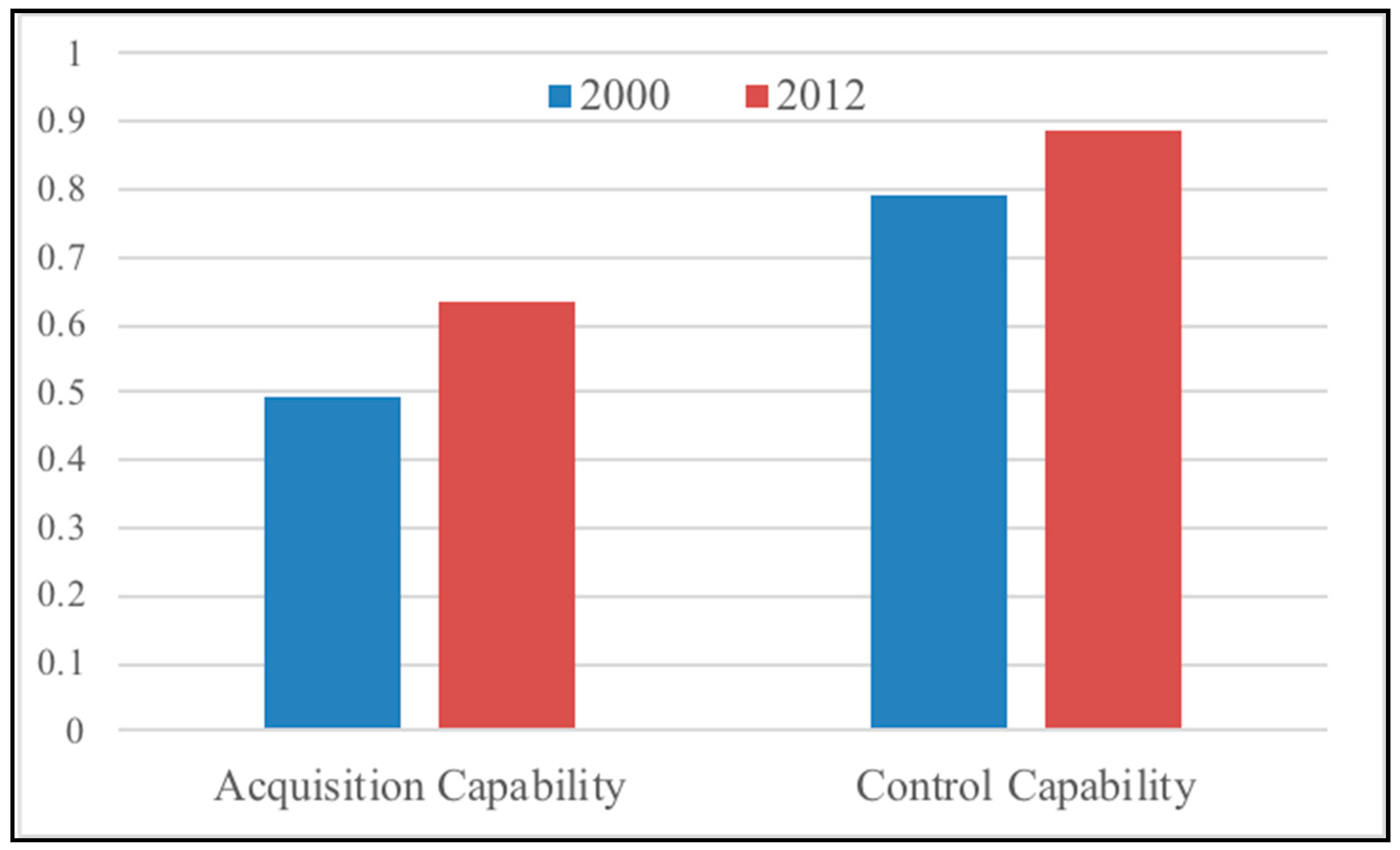
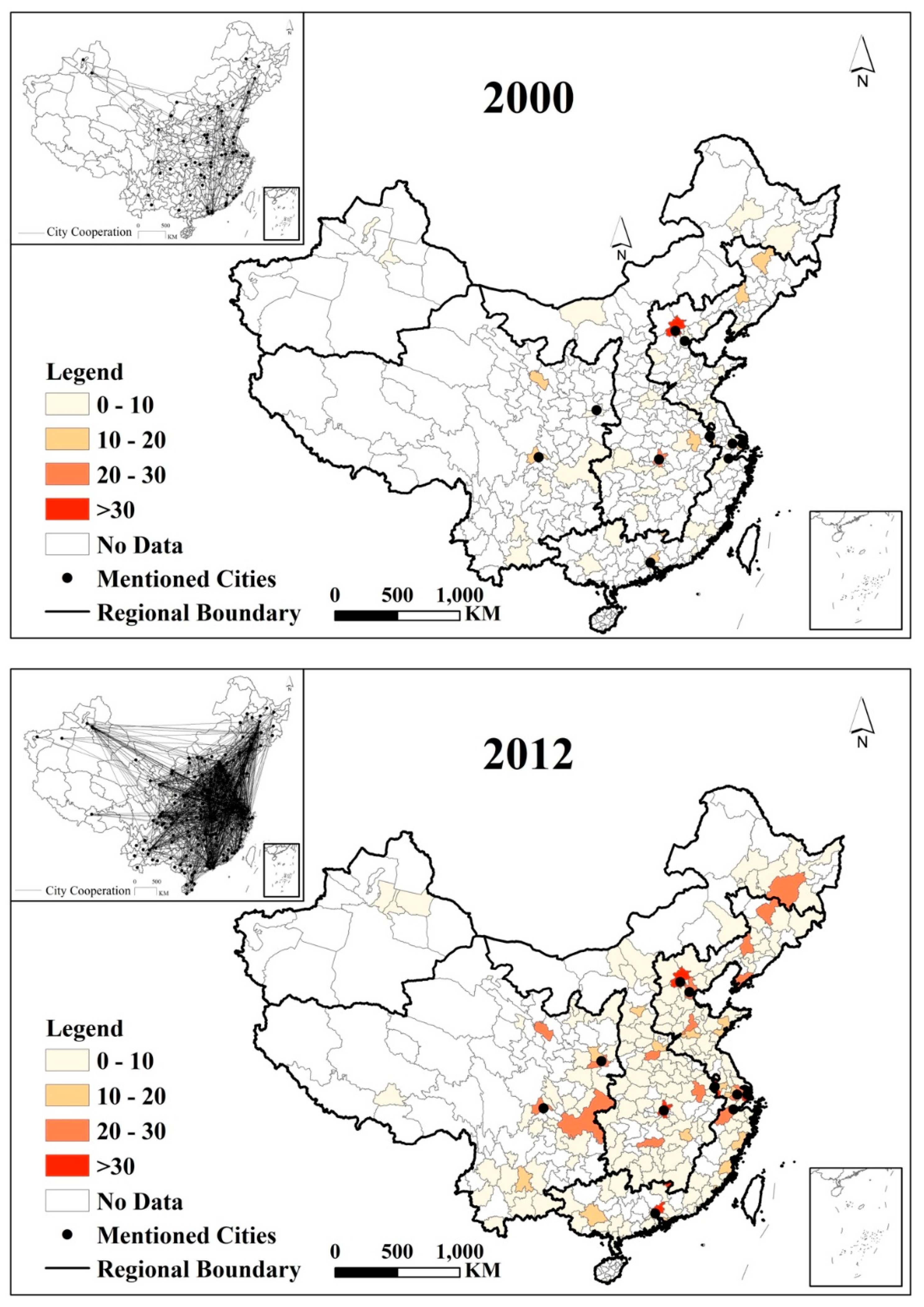


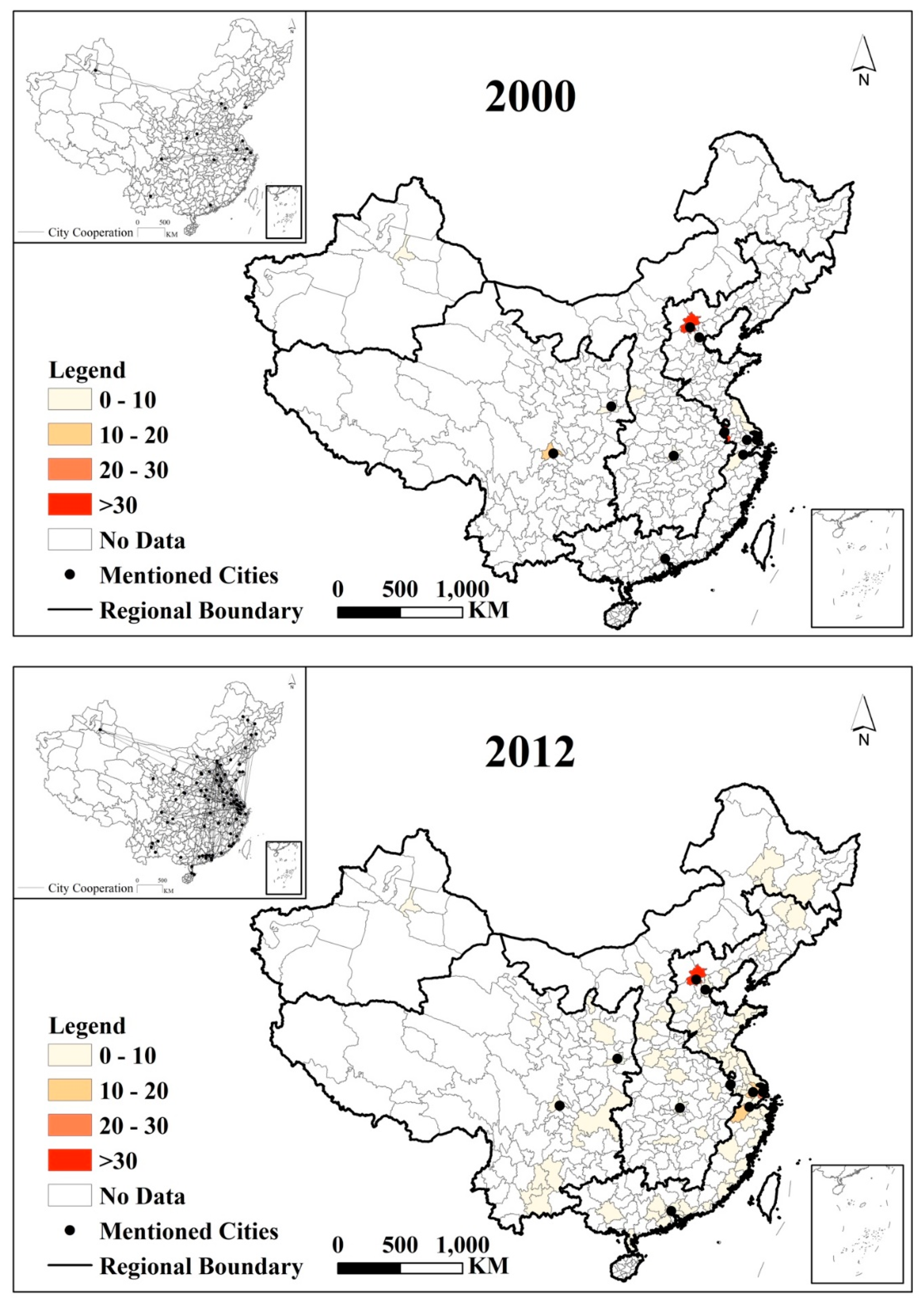
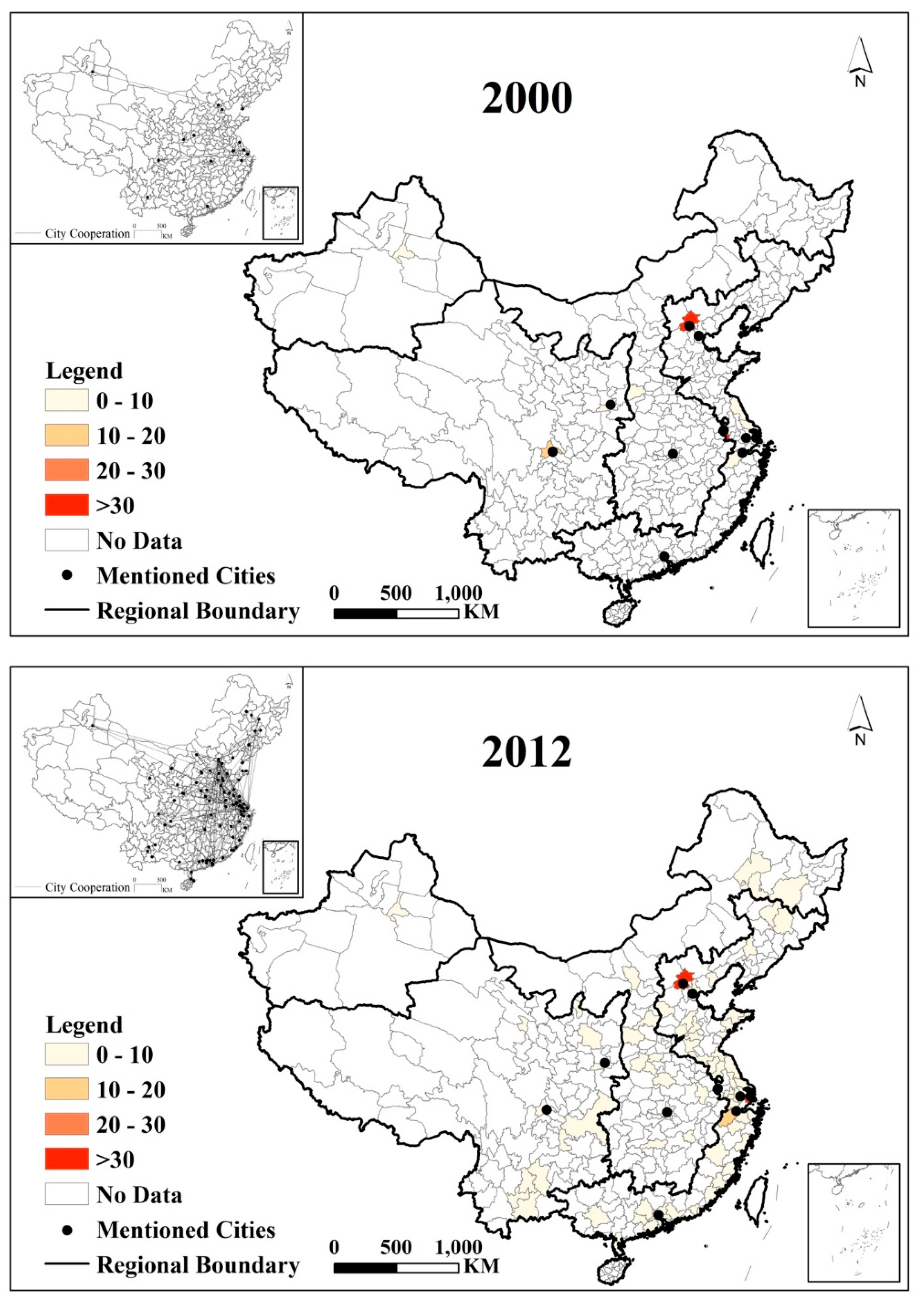
| Variables | Indicators | Description | |
|---|---|---|---|
| Dependent Variable | Innovation Output | Output Value of Biotechnology Industry (Yuan) | |
| Independent Variables | Network Capabilities | Acquisition Capability | Relative Degree Centrality |
| Control Capability | Relative Betweenness Centrality | ||
| Innovation Resources | Talents | Number of Employees (person) | |
| Innovation Subjects | Firms | Total of Collective, Personal, Corporate Capital (Yuan) | |
| Control Variables | Innovation Climate | Globalization | Total of Hong Kong, Macao and Taiwan, Foreign Capital (Yuan) |
| Marketization | State-owned Capital (Yuan) | ||
| Institution | National Advanced Science and Technology Center: Yes-1, No-0 | ||
| Year | Raw Data | Cooperation Frequency | Size | |||
|---|---|---|---|---|---|---|
| SKN | TKN | SKN | TKN | SKN | TKN | |
| 2000 | 1418 | 1997 | 250 | 77 | 60 | 15 |
| 2001 | 1716 | 1184 | 353 | 63 | 71 | 22 |
| 2002 | 2212 | 1380 | 511 | 84 | 92 | 26 |
| 2003 | 2833 | 1921 | 691 | 128 | 103 | 30 |
| 2004 | 3736 | 2099 | 1014 | 161 | 135 | 37 |
| 2005 | 4828 | 2730 | 1534 | 146 | 154 | 41 |
| 2006 | 6016 | 3109 | 2027 | 158 | 172 | 43 |
| 2007 | 7504 | 3682 | 2686 | 177 | 187 | 47 |
| 2008 | 9475 | 5302 | 3177 | 252 | 206 | 57 |
| 2009 | 11,466 | 6249 | 3842 | 310 | 205 | 82 |
| 2010 | 11,118 | 15,983 | 3387 | 670 | 202 | 86 |
| 2011 | 13,635 | 17,052 | 4776 | 578 | 223 | 95 |
| 2012 | 16,297 | 14,335 | 5885 | 397 | 224 | 88 |
| Total | 92,254 | 77,023 | 30,133 | 3201 1 | - | |
| Variables | Indicators | 2002 | 2012 | |||||
|---|---|---|---|---|---|---|---|---|
| East | Central | West | East | Central | West | |||
| Independent Variables | Network capability | Acquisition Capability | 470,200 * [0.02] | 374,300 [0.23] | 703,300 * [0.02] | −885,700 [0.20] | −534,000 [0.49] | −662,400 [0.62] |
| Innovation Resources | Talents | 123.90 *** [0.00] | 236.20 *** [0.00] | 52.47 [0.41] | 924.30 *** [0.00] | 637.50 *** [0.00] | 657.10 * [0.04] | |
| Innovation Subjects | Firms | 1.27 *** [0.00] | −0.42 [0.59] | −3.15 [0.21] | 1.11 [0.12] | 1.31 [0.22] | 0.31 [0.85] | |
| Control Variables | Innovation Climate | Globalization | 1.21 *** [0.00] | −1.66 [0.65] | 36.01 * [0.04] | 0.60 [0.31] | 2.73 [0.47] | 5.22 [0.40] |
| Marketization | −0.63 *** [0.00] | 0.14 [0.93] | 3.97 * [0.02] | −5.83 ** [0.01] | −6.26 [0.20] | 0.98 [0.77] | ||
| Institution | 397,700 # [0.07] | −340,300 [0.39] | 1,975,000 * [0.02] | 399,500 [0.73] | −354,300 [0.77] | 574,500 [0.77] | ||
| Intercept | −544,900 ** [0.01] | 468,800 [0.55] | ||||||
| Adjusted R2 | 0.95 | 0.85 | ||||||
| Observations | 75 | 196 2 | ||||||
| Variables | Indicators | 2002 | 2012 | |||||
|---|---|---|---|---|---|---|---|---|
| East | Central | West | East | Central | West | |||
| Independent Variables | Network Capability | Control Capability | 434,700 ** [0.00] | 162,500 [0.46] | 618,400 [0.56] | −2,591,000 * [0.04] | −436,100 [0.79] | −3,652,000 [0.46] |
| Innovation Resources | Talents | 113.50 *** [0.00] | 240.40 *** [0.00] | 94.15 [0.33] | 888.50 *** [0.00] | 642.60 *** [0.00] | 755.50 * [0.02] | |
| Innovation Subjects | Firms | 1.39 *** [0.00] | −0.47 [0.49] | −2.86 [0.50] | 1.47 * [0.05] | 1.27 [0.23] | −0.01 [0.99] | |
| Control Variables | Innovation Climate | Globalization | 1.19 *** [0.00] | −1.74 [0.59] | 30.52 [0.15] | 0.84 [0.16] | 2.53 [0.51] | 8.78 [0.31] |
| Marketization | −0.67 *** [0.00] | 0.16 [0.92] | 4.06 * [0.02] | −5.41 ** [0.01] | −6.30 [0.20] | 2.85 [0.54] | ||
| Institution | 45300 * [0.02] | −290,900 [0.45] | 2,034,000 * [0.03] | 88,470 [0.93] | −384,600 [0.72] | 64,700 [0.97] | ||
| Intercept | −110,800 [0.38] | −131,200 [0.83] | ||||||
| Adjusted R2 | 0.95 | 0.85 | ||||||
| Observations | 75 | 196 | ||||||
| Variables | Indicators | East | Central | West | East | Central | West | |
|---|---|---|---|---|---|---|---|---|
| Independent Variables | Network Capabilities | Acquisition Capability | −5,513,000 * [0.03] | −4,751,000 [0.18] | −6,555,000 [0.25] | |||
| Control Capability | −2,593,000 [0.13] | −1,048,000 [0.81] | −791,600 [0.93] | |||||
| Innovation Resources | Talents | 1025 *** [0.00] | 660.10 [0.11] | 452.60 [0.60] | 1080 *** [0.00] | 682.70 [0.13] | 379.90 [0.66] | |
| Innovation Subjects | Firms | 0.67 [0.62] | 1.20 [0.73] | 0.67 [0.85] | 0.26 [0.84] | 0.70 [0.88] | 0.98 [0.83] | |
| Control Variables | Innovation Climate | Globalization | 1.50 [1.65] | 8.41 [0.27] | 13.60 [0.29] | 0.96 [0.36] | 6.02 [0.48] | 9.29 [0.66] |
| Marketization | −5.61 # [0.07] | −14.36 [0.24] | 15.79 [0.50] | −5.82 # [0.07] | −12.62 [0.31] | 8.41 [0.81] | ||
| Institution | −2,121,000 [0.43] | 868,500 [0.84] | 34,410 [1.00] | −2,807,000 [0.25] | −263,500 [0.95] | −1,590,000 [0.72] | ||
| Intercept | 5,822,000 # [0.08] | 899,200 [0.65] | ||||||
| Adjusted R2 | 0.80 | 0.79 | ||||||
| Observations | 75 3 | |||||||
© 2019 by the authors. Licensee MDPI, Basel, Switzerland. This article is an open access article distributed under the terms and conditions of the Creative Commons Attribution (CC BY) license (http://creativecommons.org/licenses/by/4.0/).
Share and Cite
Li, D.; Wei, Y.D.; Miao, C.; Wu, Y.; Xiao, W. Innovation, Network Capabilities, and Sustainable Development of Regional Economies in China. Sustainability 2019, 11, 4770. https://doi.org/10.3390/su11174770
Li D, Wei YD, Miao C, Wu Y, Xiao W. Innovation, Network Capabilities, and Sustainable Development of Regional Economies in China. Sustainability. 2019; 11(17):4770. https://doi.org/10.3390/su11174770
Chicago/Turabian StyleLi, Dandan, Yehua Dennis Wei, Changhong Miao, Yangyi Wu, and Weiye Xiao. 2019. "Innovation, Network Capabilities, and Sustainable Development of Regional Economies in China" Sustainability 11, no. 17: 4770. https://doi.org/10.3390/su11174770
APA StyleLi, D., Wei, Y. D., Miao, C., Wu, Y., & Xiao, W. (2019). Innovation, Network Capabilities, and Sustainable Development of Regional Economies in China. Sustainability, 11(17), 4770. https://doi.org/10.3390/su11174770







